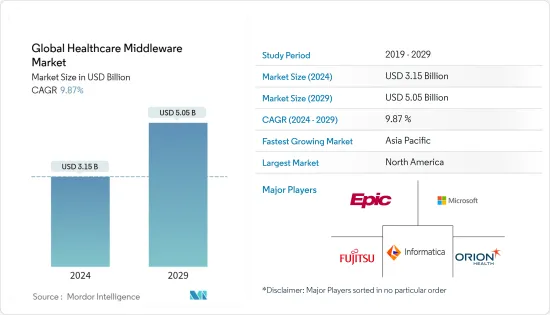
|
시장보고서
상품코드
1434488
세계의 헬스케어 미들웨어 : 시장 점유율 분석, 산업 동향 및 통계, 성장 예측(2024-2029년)Global Healthcare Middleware - Market Share Analysis, Industry Trends & Statistics, Growth Forecasts (2024 - 2029) |
||||||
세계 헬스케어 미들웨어 시장 규모는 2024년 31억 5,000만 달러로 추정되며, 2029년까지 50억 5,000만 달러에 달할 것으로 예상되며, 예측 기간(2024-2029년) 동안 9.87%의 CAGR로 성장할 것으로 예상됩니다.

헬스케어 미들웨어 시장은 전 세계적으로 발전하고 있는 헬스케어 인프라, 헬스케어 시스템 관리에 있어 첨단 기기 및 빅데이터 사용 등의 요인으로 인해 빠르게 성장하고 있습니다. 또한, 정부의 헬스케어 투자 증가와 의료 서비스 제공자가 환자의 건강 관리를 개선하기 위해 애플리케이션과 클라우드 기반 서비스를 적용함에 따라 헬스케어 미들웨어 시스템에 대한 수요가 증가하고 있습니다.
COVID-19 감염병의 대유행으로 인해 의료 서비스 제공자 및 기타 사용자가 절차 및 리소스 할당을 간소화하고 진단 테스트 연구 및 개발에 사용할 수 있는 데이터에서 영향력 있는 결과를 얻기 위해 사용하는 보건의료 소프트웨어 솔루션 및 도구에 대한 수요와 도입 비율이 증가했습니다. 데이터 분석의 중요성은 지난 몇 년 동안 크게 증가했으며, 팬데믹도 시장 성장에 큰 영향을 미치고 있습니다. 연구에 따르면, COVID-19 전염병과 싸우기 위해 의료 분야에서 빅데이터 활용이 증가하고 있는 것으로 나타났습니다. 예를 들어, 2021년 3 월에 발행 된 Sage Journal의 "아시아에서 COVID-19 통제에서 빅데이터와 디지털 기술의 역할 검토 : 공중 보건 이익과 개인 정보 보호"라는 제목의 기사는 COVID-19 전염병 기간 동안 싱가포르, 대만 및 남부에서 다음과 같이 결론을 내 렸습니다. 결론을 내리고 있습니다. 한국과 홍콩은 SARS-CoV-2의 확산을 막기 위한 기존의 공중보건 조치를 촉진하고 강화하는 데 있어 디지털 기술과 빅데이터의 잠재력이 크다는 것을 입증했습니다. 전염병 통제를 위한 빅데이터의 도입은 헬스케어 미들웨어 시장의 성장을 촉진하고 있습니다.
Population health는 빅데이터, 환자 참여, 의료 및 치료 제공을 통해 인구의 요구(공중보건)를 이해합니다. 이는 여러 의료 기술 리소스에 걸쳐 있는 환자 데이터를 하나의 실용적인 기록으로 통합하여 의료 서비스 제공자에게 환자의 종합적인 임상적 그림을 제공합니다. 의료 시스템에는 방대한 데이터가 있으며, 이 데이터를 효과적으로 활용하면 국민 건강 관리 전략을 효과적으로 개발할 수 있습니다.
따라서 헬스케어 분야에서 기술의 중요성이 높아짐에 따라 조사 대상 시장은 예측 기간 동안 건전한 성장을 이룰 것으로 예상됩니다.
헬스케어 미들웨어 시장 동향
클라우드 기반 소프트웨어는 예측 기간 동안 큰 폭의 성장을 이룰 것으로 예상
클라우드 기반 솔루션은 비교적 새로운 접근 방식이며, 주로 내부 인프라가 부족한 조직에서 주로 사용됩니다. 이 소프트웨어의 도입 비용은 온프레미스 시스템보다 저렴합니다. 또한, 이 소프트웨어는 사내 유지보수의 필요성을 없애고, 이는 수요 증가를 촉진하는 주요 요인이 될 것으로 보입니다. 클라우드 기반 제공 모델을 통해 소프트웨어는 확장성(종량제 스토리지 사용량)에 대한 유연성이 매우 뛰어납니다. 스토리지 리소스를 간소화하고 통합하여 임상 정보의 부서별 사일로를 제거함으로써 비용을 절감하고 워크플로우를 강화합니다. 병원 및 기타 의료 시설에서 이러한 플랫폼의 채택이 증가함에 따라 이 부문의 성장을 주도하고 있습니다. 데이터에 대한 원격 액세스, 실시간 데이터 추적, 보다 단순하고 복잡한 물리적 생태계는 클라우드 기반 시스템과 관련된 주목할 만한 이점입니다.
최근 제품 출시와 주요 시장 기업들이 채택한 인수합병 및 합병과 같은 전략이 이 부문의 성장을 촉진할 것입니다. 예를 들어, 마이크로소프트는 2022년 3월에 Azure Health Data Services를 출시했습니다. 이는 조직이 개방형 표준인 FHIR(Fast Healthcare Interoperability Resources) 및 DICOM(Digital Imaging and Communications in Medicine)으로 의료 데이터를 업로드, 저장, 관리 및 분석할 수 있는 서비스형 플랫폼이다, 관리, 분석할 수 있는 서비스형 플랫폼입니다. 이러한 제품 출시가 시장 성장을 견인하고 있습니다. 또한, 시장 참여자들 간의 파트너십도 시장 부문의 성장을 촉진하고 있습니다. 예를 들어, 2022년 3월 Snowflake는 헬스케어 및 생명과학 데이터 클라우드를 출시했습니다. 이를 통해 헬스케어 기업들은 기술 및 조직적 데이터 사일로를 제거한 단일 통합 크로스 클라우드 데이터 플랫폼을 이용할 수 있습니다. 이를 통해 조직은 중요한 기밀 데이터를 대규모로 안전하게 중앙에서 관리, 통합 및 교환할 수 있습니다. Snowflake는 높은 수준의 데이터 보안과 거버넌스를 보장하며, 내장된 기능과 확장된 파트너 네트워크를 통해 기업이 컴플라이언스 요구 사항을 충족하고 업계 규정을 준수할 수 있도록 지원합니다.
따라서 위의 요인들은 예측 기간 동안 해당 부문의 성장에 기여할 것으로 예상됩니다.
북미, 헬스케어 미들웨어 시장에서 큰 점유율을 차지할 것으로 예상
북미 지역이 헬스케어 미들웨어 시장에서 큰 비중을 차지할 것으로 예상되지만, 미국이 이 지역을 지배할 것으로 예상됩니다. 미국에는 방대한 양의 환자 정보가 존재합니다. 이 데이터를 쉽게 분석하기 위해 제약회사와 바이오 제약회사는 수년간의 연구 개발 데이터를 의료 데이터베이스에 축적해 왔으며, 지난 10년간 지불자와 의료 서비스 제공자는 환자 기록을 디지털화해 왔습니다.
최근 기술 발전과 다양한 기업 간의 전략적 제휴가 시장 성장에 중요한 역할을 하고 있습니다. 예를 들어, 2021년 2월 14개 주요 의료 서비스 제공업체들이 헬스케어 분석을 활용하여 의료 관련 인사이트를 강화하기 위해 새로운 회사인 Truveta를 설립했습니다. 이 노력에 참여한 의료 제공자에는 AdventHealth, Advocate Aurora Health, Baptist Health of Northeast Florida, Bon Secours Mercy Health, CommonSpirit Health가 포함된다, Hawaii Pacific Health, Henry Ford Health System, Memorial Hermann Health System, Northwell Health, Novant Health, Providence health system. 센터라 헬스케어, 테넷 헬스, 트리니티 헬스 등이 있습니다. 이러한 주요 의료 시스템 전반의 정규화된 정형 및 비정형 데이터 유형을 사용하는 이 회사의 플랫폼은 진단, 지리 및 인구 통계에 대한 접근 방식을 촉진하는 데 도움이 됩니다.
또한, 새로운 플랫폼의 출시도 시장 성장을 촉진하고 있습니다. 예를 들어, Mayo Clinic은 2021년 4월에 원격 환자 모니터링 및 원격 의료 프로그램에 사용되는 mHealth 기기의 데이터를 분석하고 진단 및 의사 결정을 지원하기 위해 AI 도구를 적용하는 원격 진단 및 관리 플랫폼(RDMP)이라는 새로운 플랫폼을 출시했습니다. 원격 진단 및 관리 플랫폼(RDMP)을 출시했습니다.
따라서 위의 요인으로 인해 조사 대상인 미국 시장은 예측 기간 동안 유리한 성장세를 보일 것으로 예상됩니다.
기타 혜택
- 엑셀 형식의 시장 예측(ME) 시트
- 3개월간 애널리스트 지원
목차
제1장 서론
- 조사 가정과 시장 정의
- 조사 범위
제2장 조사 방법
제3장 주요 요약
제4장 시장 역학
- 시장 개요
- 시장 성장 촉진요인
- 헬스케어의 첨단 기기와 그 이용에 대한 수요 증가
- 연구개발 투자 증가와 유리한 규제 인프라
- 시장 성장 억제요인
- 숙련된 전문가의 부족
- 투자와 유지보수의 고비용
- Porter's Five Forces 분석
- 신규 참여업체의 위협
- 구매자/소비자의 협상력
- 공급 기업의 교섭력
- 대체품의 위협
- 경쟁 기업 간의 경쟁 강도
제5장 시장 세분화
- 유형별
- 통합 미들웨어
- 통신 미들웨어
- 플랫폼 미들웨어
- 기타
- 형태별
- 클라우드 기반
- 온프레미스
- 하이브리드
- 용도별
- 임상
- 재무
- 운영·관리
- 최종사용자별
- 병원
- 임상 검사실
- 기타
- 지역별
- 북미
- 미국
- 캐나다
- 멕시코
- 유럽
- 독일
- 영국
- 프랑스
- 이탈리아
- 스페인
- 기타 유럽
- 아시아태평양
- 중국
- 일본
- 인도
- 호주
- 한국
- 기타 아시아태평양
- 중동 및 아프리카
- GCC
- 남아프리카공화국
- 기타 중동 및 아프리카
- 남미
- 브라질
- 아르헨티나
- 기타 남미
- 북미
제6장 경쟁 상황
- 기업 개요
- Informatica
- Epic Systems Corporation
- Microsoft Corporation
- Fujitsu Ltd.
- Orion Health group
- International Business Machines Corporation
- Oracle Corporation
- InterSystems Corporation
- Abbott Laboratories(Alere)
- Siemens AG
제7장 시장 기회와 향후 동향
ksm 24.03.06The Global Healthcare Middleware Market size is estimated at USD 3.15 billion in 2024, and is expected to reach USD 5.05 billion by 2029, growing at a CAGR of 9.87% during the forecast period (2024-2029).

The Healthcare middleware market is growing at a rapid pace owing to the factors such as the use of advanced devices and big data in the management of the healthcare systems coupled with the developing healthcare infrastructure across the globe. In addition, rising healthcare investments by the government and the adaptation of applications and cloud-based services by healthcare providers for better health management for patients are augmenting the demand for middleware systems in healthcare.
The COVID-19 pandemic increased the demand and deployment rate of the healthcare software solutions and tools used by healthcare providers and other users to streamline the procedures, and resource allocation and get the impactful result from the available data for the research and development of diagnostics tests and treatment of COVID-19 along with the vaccine development. The importance of data analysis has increased tremendously over years and the pandemic has also led to a significant impact on the growth of the market. The studies have revealed that there has been increasing usage of big data in healthcare to fight against the Covid-19 pandemic. For instance, a Sage Journal article titled 'Review of the role of big data and digital technologies in controlling COVID-19 in Asia: Public health interest vs. privacy' published in March 2021 concluded that during COVID-19, Singapore, Taiwan, South Korea, and Hong Kong have demonstrated the enormous potential that digital technologies and big data have in facilitating and strengthening traditional public health measures to combat the spread of SARS-CoV-2. The implementation of big data for controlling the pandemic is also propelling the growth of the healthcare middleware market.
Population health brings together an understanding of population needs (public health) through Big Data, patient engagement, and health and care delivery. It is the aggregation of patient data across multiple health technology resources, into a single actionable record that provides a comprehensive clinical picture of patients to the healthcare providers. The health systems have huge data at their disposal and utilizing this data effectively can lead to the development of population health management strategies effectively.
Hence, owing to the rising significance of technology in healthcare, the market studied is believed to witness healthy growth over the forecast period.
Healthcare Middleware Market Trends
Cloud Based Software is Believed to Witness Significant Growth Over the Forecast Period
Cloud-based solutions are comparatively newer approaches and are mostly used by organizations that lack the internal infrastructure to support them. The installation cost of this software is lower than the on-premise systems. Moreover, this software eradicates the need for in-house maintenance, which is likely to be the prime factor driving their increasing demand. The cloud-based delivery model makes the software extremely flexible regarding scalability (pay-as-you-go storage utilization). It simplifies and consolidates storage resources to reduce costs and enhance workflow by eliminating departmental silos of clinical information. Increasing adoption of these platforms by hospitals and other healthcare facilities is driving segment growth. Remote access to data, real-time data tracking, and a simpler complex physical ecosystem are notable benefits associated with cloud-based systems.
The factors such as recent product launches and other strategies such as mergers and acquisitions adopted by the key market players will boost the segment growth. For instance, in March 2022, Microsoft launched Azure Health Data Services. It is a platform-as-a-Service that allows organizations to upload, store, manage and analyze healthcare data in the open standards Fast Healthcare Interoperability Resources (FHIR)and Digital Imaging and Communications in Medicine (DICOM). Such launches are propelling the growth of the market. Additionally, the partnership among the market players is also augmenting the growth of the market segment. For Instance, in March 2022, Snowflake launched the Healthcare and Life Sciences Data Cloud. It will enable healthcare companies to have a single, integrated, and cross-cloud data platform that eliminates technical and institutional data silos. This will enable organizations to securely centralize, integrate, and exchange critical and sensitive data at scale. Snowflake ensures high levels of data security and governance, and its built-in capabilities and extended partner network allow companies to meet compliance requirements and satisfy industry regulations.
Thus, the above-mentioned factors are expected to contribute to the segment growth over the forecast period.
North America is Expected to have Significant Market Share in the Healthcare Middleware Market
North America is believed to witness a significant share in the healthcare middleware market whereas the United States is expected to dominate the region. The United States has a vast array of patient information. To easily analyze this data, pharmaceutical and biopharmaceutical companies have been accumulating years of research and development data into medical databases, while payers and providers have digitized their patient records over the last decade.
Recent advancements in technology and strategic collaborations among various companies are playing a key role in market growth. For instance, in February 2021, Fourteen leading healthcare providers partnered to form Truveta, a new company that will leverage healthcare analytics for enhanced care insights. The providers involved in the effort include AdventHealth, Advocate Aurora Health, Baptist Health of Northeast Florida, Bon Secours Mercy Health, CommonSpirit Health, Hawaii Pacific Health, Henry Ford Health System, Memorial Hermann Health System, Northwell Health, Novant Health, Providence health system, Sentara Healthcare, Tenet Health, and Trinity Health. The company's platform by using the normalizing structured and unstructured data types from across those major health systems will help to drive approaches to diagnoses, geographies, and demographics.
Furthermore, the launch of new platforms is also boosting the growth of the market. For Instance, in April 2021, Mayo Clinic launched a new platform named the Remote Diagnostic and Management Platform (RDMP) for analyzing data from mHealth Devices used in remote patient monitoring and telehealth programs and applying AI tools for diagnosis and decision support.
Thus, owing to the abovementioned factors, the studied market in the United States is expected to show lucrative growth over the forecast period.
Healthcare Middleware Industry Overview
Global healthcare middleware market is moderately consolidated and competitive. Market players are focusing on product innovations, new product launches and regional expansions to increase their market share. The key market players operating in the market include Informatica, Epic Systems Corporation, Microsoft Corporation, Fujitsu Ltd., and Orion Health group among others.
Additional Benefits:
- The market estimate (ME) sheet in Excel format
- 3 months of analyst support
TABLE OF CONTENTS
1 INTRODUCTION
- 1.1 Study Assumptions and Market Definition
- 1.2 Scope of the Study
2 RESEARCH METHODOLOGY
3 EXECUTIVE SUMMARY
4 MARKET DYNAMICS
- 4.1 Market Overview
- 4.2 Market Drivers
- 4.2.1 Increasing Demand for the Advanced Devices and Its Usage in Healthcare
- 4.2.2 Increasing Research and Development Investments and Favorable Regulatory Infrastructure
- 4.3 Market Restraints
- 4.3.1 Lack of Skilled Professionals
- 4.3.2 High Cost of Investment and Maintenance
- 4.4 Porter's Five Force Analysis
- 4.4.1 Threat of New Entrants
- 4.4.2 Bargaining Power of Buyers/Consumers
- 4.4.3 Bargaining Power of Suppliers
- 4.4.4 Threat of Substitute Products
- 4.4.5 Intensity of Competitive Rivalry
5 MARKET SEGMENTATION (Market Size by Value - USD Million)
- 5.1 By Type
- 5.1.1 Integration Middleware
- 5.1.2 Communication Middleware
- 5.1.3 Platform Middleware
- 5.1.4 Others
- 5.2 By Mode
- 5.2.1 Cloud Based
- 5.2.2 On-Premise
- 5.2.3 Hybrid
- 5.3 By Application
- 5.3.1 Clinical
- 5.3.2 Financial
- 5.3.3 Operational & Administrative
- 5.4 By End-User
- 5.4.1 Hospitals
- 5.4.2 Clinical Laboratories
- 5.4.3 Others
- 5.5 Geography
- 5.5.1 North America
- 5.5.1.1 United States
- 5.5.1.2 Canada
- 5.5.1.3 Mexico
- 5.5.2 Europe
- 5.5.2.1 Germany
- 5.5.2.2 United Kingdom
- 5.5.2.3 France
- 5.5.2.4 Italy
- 5.5.2.5 Spain
- 5.5.2.6 Rest of Europe
- 5.5.3 Asia-Pacific
- 5.5.3.1 China
- 5.5.3.2 Japan
- 5.5.3.3 India
- 5.5.3.4 Australia
- 5.5.3.5 South Korea
- 5.5.3.6 Rest of Asia-Pacific
- 5.5.4 Middle-East and Africa
- 5.5.4.1 GCC
- 5.5.4.2 South Africa
- 5.5.4.3 Rest of Middle-East and Africa
- 5.5.5 South America
- 5.5.5.1 Brazil
- 5.5.5.2 Argentina
- 5.5.5.3 Rest of South America
- 5.5.1 North America
6 COMPETITIVE LANDSCAPE
- 6.1 Company Profiles
- 6.1.1 Informatica
- 6.1.2 Epic Systems Corporation
- 6.1.3 Microsoft Corporation
- 6.1.4 Fujitsu Ltd.
- 6.1.5 Orion Health group
- 6.1.6 International Business Machines Corporation
- 6.1.7 Oracle Corporation
- 6.1.8 InterSystems Corporation
- 6.1.9 Abbott Laboratories (Alere)
- 6.1.10 Siemens AG











